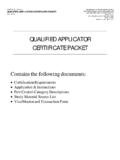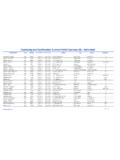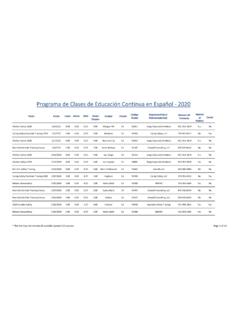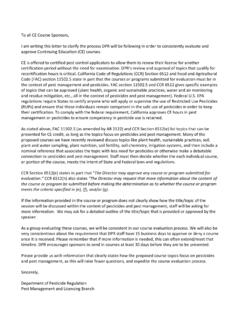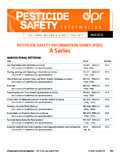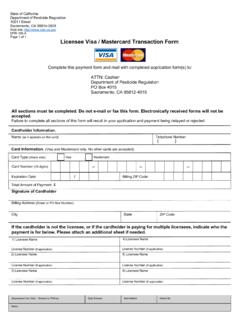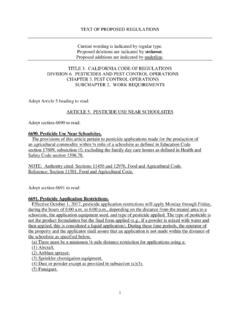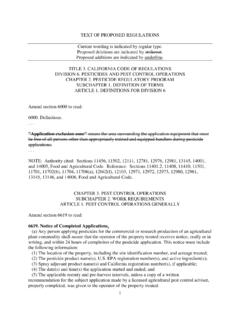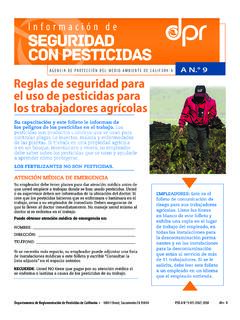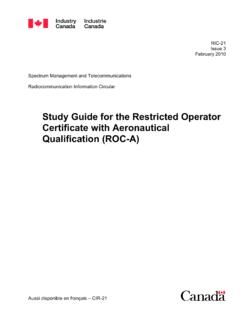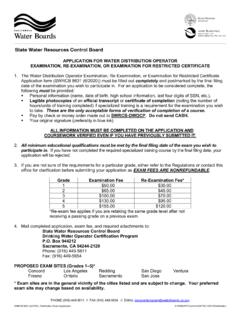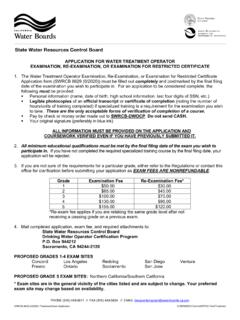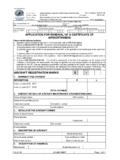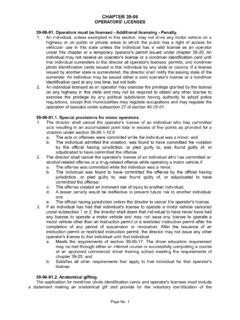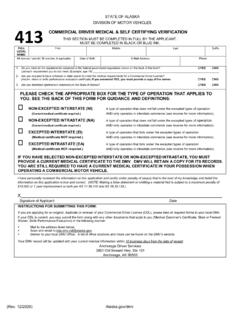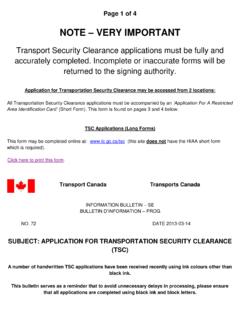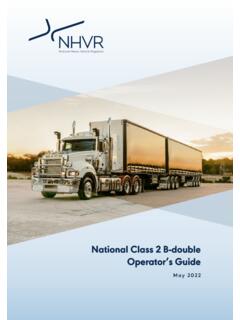Transcription of Chapter 4 Private Applicator Certification
1 4-1 (Rev. 12-14) Chapter 4 Private Applicator Certification Introduction This Chapter describes DPR s Private Applicator Certification Program. DPR licensing and Certification of commercial pesticide applicators are discussed in Compendium Volume 1, General Administration of the Pesticide Use Enforcement Program. This Chapter does not address commercial pesticide applicators such as those certified by the California Department of Consumer Affairs (Structural Pest Control Board) and the California Department of Public Health (Vector-Borne Disease Section). About the Private Applicator Certification Program The Private Applicator Certification Program was initially established in 1977 as a component of California's State Plan for Certification of Pesticide Applicators (commercial and Private ) who supervised or used restricted use pesticides.
2 It resulted from amendments to FIFRA in 1972. In 1996, the Food and Agricultural Code was amended (added FAC sections 14090 - to Division 6), separating the Private Applicator Certification program from the restricted materials permitting process and establishing continuing education requirements for renewal. The program was designed to meet the EPA requirements for a Private Applicator Certification program. Private Applicator , defined Private Applicator is defined as: An individual11 Individual can be the operator of the property, the operator s authorized representative (with written authorization), or the operator s employee. who uses or supervises the use of a pesticide for the purpose of producing an agricultural commodity as defined by Title 40 on property owned, leased, or rented by him/her or his/her employer; or Code of Federal Regulations, section (a)(5) (July 1, 2013)22 Due to a nonsubstantive change to the definition of Private Applicator , it is necessary to date the federal regulation code [40 CFR (a)(5)] referenced in the definition, since this is an incorporation by reference.
3 A householder who uses or supervises the use of a pesticide outside the confines of a residential dwelling for the purpose of controlling ornamental, plant, or turf pests on residential property owned, leased, or rented by that householder. (Reference: 3 CCR section 6000) Continued on next page 4-2 (Rev. 12-17) Private Applicator Certification , Continued Certified Private Applicator , defined Certified Private Applicator is defined as: A Private Applicator holding a valid Private Applicator certificate issued by the commissioner (or the director in any county where there is no commissioner). (Reference: 3 CCR section 6000)Who may possess, use, or supervise the use of a restricted material Certified Private applicators and certified commercial applicators may possess, use, or supervise the use of pesticides classified as restricted use pesticides by the EPA or designated as restricted materials by DPR, without additional supervision.
4 It is unlawful for a Private Applicator to possess, use, or supervise the use of a restricted material in accordance with FAC section 14015 unless that person has a valid Private Applicator certificate. (Reference: FAC section 14090) Noncertified applicators may use restricted materials provided they aradequately supervised by a certified Applicator . e Supervision of uncertified applicators Whenever a noncertified Applicator handles restricted use pesticides or restricted materials, they must be adequately supervised by a certified Applicator . The level of supervision required is either specified on the restricted use pesticide label or in regulation. For the most highly toxic pesticides, the label will define direct supervision to require the certified Applicator to be physically present when the pesticide is handled by a noncertified Applicator .
5 Federally restricted use pesticides are clearly identified by a box at the very top of the label s front panel that states the classification, the need for Applicator Certification , and the supervision requirement. Continued on next page 4-3 (Rev. 12-14) Private Applicator Certification , Continued Supervision of uncertified applicators (continued) Example: Continued on next page RESTRICTED USE PESTICIDE Due to Reproductive Effects For retail sale to and use only by certified applicators or persons under their direct supervision and only for those uses covered by the certified Applicator s Certification . Direct supervision for this product is defined as the certified Applicator being physically present during mixing, loading, equipment repair and equipment cleaning.
6 Certified applicators must ensure that all persons involved in these activities under their direct supervision are informed of the precautionary statements. When the pesticide labeling or regulations require that the certified Applicator be physically present, the certified Applicator must be physically located on the application site or contiguous parcel where the pesticide-handling activity is taking place. In addition: When two or more noncertified handlers are at the pesticide-handling site, the certified Applicator must maintain either visual or two-way voice contact with the handlers. When only one noncertified handler is at the pesticide-handling site, the certified Applicator must maintain the direct supervision and physically present in-line of sight visual standard.
7 The certified Applicator must be able to see the noncertified Applicator and be assured that the Applicator is safe. Voice contact alone to one noncertified handler does not meet this standard because of the possibility that a lone Applicator may be unable to seek help should a medical emergency occur. In addition, the certified Applicator must comply with the supervision standards in 3 CCR section 6406, which requires the certified Applicator to be aware of the conditions at the use site and be available to direct and/or control activities of the noncertified Applicator . The proximity of the certified Applicator to the use site shall be directly related to the actual or potential hazard of the situation. (Reference: 3 CCR section 6406) 4-4 (Rev.)
8 12-14) Private Applicator Certification , Continued Obtaining the Private Applicator Certificate A Private Applicator must become certified by the CAC or the Director in any county in which there is no CAC. Certification is accomplished through a written examination process designed to evaluate the knowledge and abilities of a Private Applicator . Each applicant must complete the Private Applicator Certificate Application form (PR-PML-045) prior to taking the examination. There is no fee for taking the Private Applicator Certificate (PAC) examination, obtaining the PAC card, or renewing the PAC card (recertification). To become certified, a Private Applicator must demonstrate competency to use and supervise the use of restricted use pesticides and restricted materials properly and safely, by passing the written examination with a minimum score of 70%.
9 Private applicators that pass the examination receive a DPR PAC card issued by CAC staff. The examination is available in both English and Spanish. The only part of the Spanish examination written in English is the pesticide label. Federal law requires all certified applicators to be able to read and understand the registered labeling. EPA currently registers only labeling written in English. What information is on the examination? Applicants shall be examined on the requirements of statutes and regulations concerning pesticide use and pest control operations including, but not limited to, knowledge of all of the following: Label directions and restrictions on use Calibration Pest control equipment Pest problems and identification Worker protection, including protective clothing and equipment Environmentally sensitive areas Continued on next page 4-5 (Rev.)
10 12-14) Private Applicator Certification , Continued Study guide The study guide for the PAC examination is the publication Pesticide Safety--A Reference Manual for Private Applicators, Publication 3383. This publication may be purchased from the local Cooperative Extension Office; ordering from the Division of Agriculture and Natural Resources website at: ; or by writing to: Division of Agriculture and Natural ResourcesUniversity of California 6701 San Pablo Avenue Oakland, California 94608 Request Publication 3383. Examination administration and security Examination administration and security is recognized nationally as a critical feature of effective programs for Certification and recertification of pesticide applicators. The PAC examination must be administered and proctored by authorized CAC staff.
